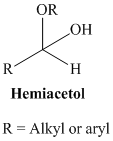
Concept explainers
(a)
Interpretation:
Describes what happen in the reaction of an
Concept Introduction:
Hydrolysis Reaction: This type of reaction involving the braking of a carbon-carbon triple, double bonds in a molecules using water.
Acid Catalyzed Hydration Reaction: The reaction involves breaking of
Acetal formation: The acid catalysts is added to the reaction of an alcohol with an aldehyde or
A hemiacetal or a hemiketal: addition of alcohol to an aldehyde or ketone which produce hemi acetal.

(b)
Interpretation:
The line structure should be draw and identified given the reactant of aldehyde and alcohol to form a hemiacetal, the transformation should be identified.
Concept Introduction:
Acetal formation: The small amount of acid catalysts is added to the reaction of an alcohol with an aldehyde or ketone, the hemi-space initially formed is converted into an acetal or a ketal substitution reaction.
A hemiacetal or a hemiketal: addition of alcohol to an aldehyde or ketone which produce hemi acetal.

Want to see the full answer?
Check out a sample textbook solution
Chapter 15 Solutions
Fundamentals of General, Organic, and Biological Chemistry (8th Edition)
- C6H12O6 is the chemical formula for a ________. polymer of carbohydrate pentose monosaccharide hexose monosaccharide all of the abovearrow_forwardIn the following list, identify the carbohydrate, the fatty acid, the amino acid, and the polypeptide: a. NH2CHRCOOH b. C6H12O6 c. (methionine)20 d. CH3(CH2)16COOHarrow_forwardA monosaccharide designated as an aldehyde sugar contains (a) a terminal carboxyl group (b) an internal carboxyl group (c) a terminal carbonyl group (d) an internal carbonyl group (e) a terminal carboxyl group and an internal carbonyl grouparrow_forward
- Identify the chiral carbon in each of the following compounds: a. citronellol; one enantiomer has the odor of geranium b. alanine, an amino acidarrow_forwardIf we attached an amine group (NH₂) to Carbon 4, what type of amine will be the result? A. Primary amine B. Secondary amine C. Tertiary amine D. Quaternary aminearrow_forwardIdentify the TRANS BOND.arrow_forward
- Monomers are linked together by removing a __ from one monomer, and a __ from another monomer. hydroxyl group; hydrogen hydroxyl group; hydroxyl group carboxyl group; hydrogen carboxyl group; phosphate hydroxyl group; carboxyl grouparrow_forwardWrite one Chemical difference and similarity between an amine and an amidearrow_forwardWhat are the names of the seven functional groups found in organic molecules? Underline the two that can act as an acid. Make the single group that acts as a base in bold lettering.arrow_forward
 Human Biology (MindTap Course List)BiologyISBN:9781305112100Author:Cecie Starr, Beverly McMillanPublisher:Cengage Learning
Human Biology (MindTap Course List)BiologyISBN:9781305112100Author:Cecie Starr, Beverly McMillanPublisher:Cengage Learning Biology (MindTap Course List)BiologyISBN:9781337392938Author:Eldra Solomon, Charles Martin, Diana W. Martin, Linda R. BergPublisher:Cengage Learning
Biology (MindTap Course List)BiologyISBN:9781337392938Author:Eldra Solomon, Charles Martin, Diana W. Martin, Linda R. BergPublisher:Cengage Learning Anatomy & PhysiologyBiologyISBN:9781938168130Author:Kelly A. Young, James A. Wise, Peter DeSaix, Dean H. Kruse, Brandon Poe, Eddie Johnson, Jody E. Johnson, Oksana Korol, J. Gordon Betts, Mark WomblePublisher:OpenStax College
Anatomy & PhysiologyBiologyISBN:9781938168130Author:Kelly A. Young, James A. Wise, Peter DeSaix, Dean H. Kruse, Brandon Poe, Eddie Johnson, Jody E. Johnson, Oksana Korol, J. Gordon Betts, Mark WomblePublisher:OpenStax College Biology Today and Tomorrow without Physiology (Mi...BiologyISBN:9781305117396Author:Cecie Starr, Christine Evers, Lisa StarrPublisher:Cengage Learning
Biology Today and Tomorrow without Physiology (Mi...BiologyISBN:9781305117396Author:Cecie Starr, Christine Evers, Lisa StarrPublisher:Cengage Learning




